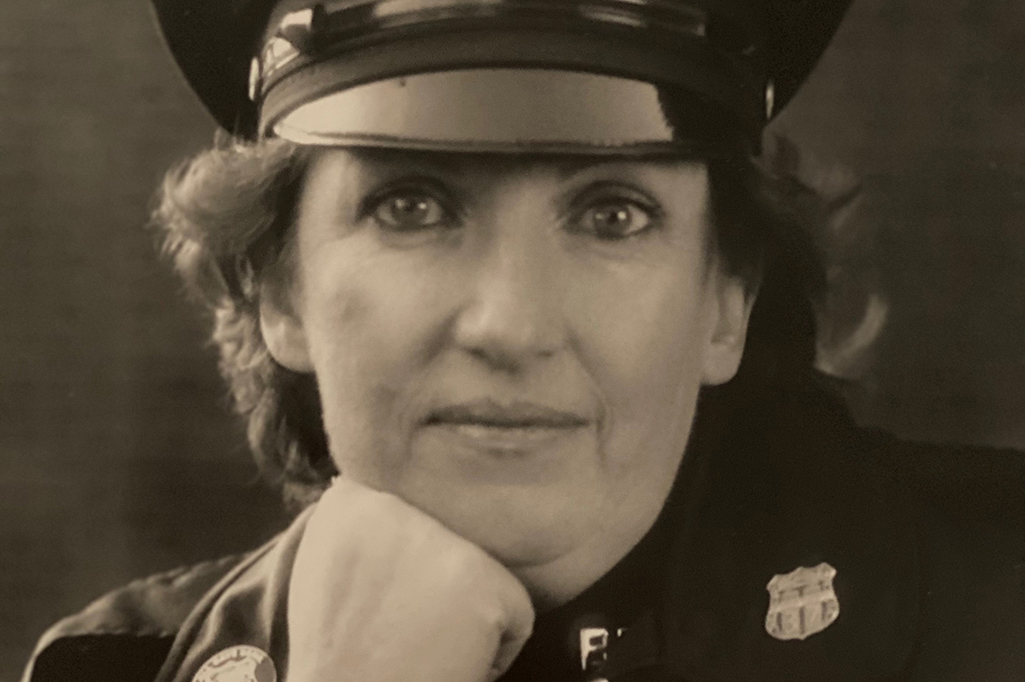A few days before the new year, I was greatly saddened to learn about the passing of retired Port Authority Police Department Sergeant Susan Martha Keane. She had died exactly two months earlier, on October 28, 2021, from a heart attack in her home in Palm Bay, Florida. She was only 62 years old.
I had come to know Sue because she was a first responder on 9/11 and a key witness to the blast wind that ripped through the lobby of the World Trade Center’s North Tower when the neighboring South Tower — along with some 800 people inside it — was blown up at 9:59 AM that morning.
I had tracked her down in December 2020 to ask her to give testimony in support of an application for a new inquest into the death of British 9/11 victim Geoff Campbell, who was attending a conference on the 106th floor of the North Tower when it was struck by an airplane at 8:46 AM. His family is seeking to overturn the verdict of his original inquest — which states that the North Tower collapsed due to the airplane impact — and establish that his actual cause of death was the North Tower’s explosive demolition.
I remember leaving a message on Sue’s voicemail and then calling her again a few days later, doubtful that I would ever get to speak to her. To my surprise, she picked up the phone and told me she had been thinking about my message all weekend. After we spoke for an hour, she agreed to provide a statement for the application and to testify in person if the new inquest were granted.
She was not surprised to receive my call. In fact, she had been waiting for it for almost 20 years. Not long after 9/11, a friend of hers predicted that people would eventually come looking for her — perhaps around the 20th anniversary of the event — asking her to tell her story again. After years of mentally preparing for this moment, she had come to see herself as a living historical document. She felt it was her duty to tell the world what happened that day.
I first learned about Sue from a presentation by my colleague Dr. Graeme MacQueen at the Justice In Focus conference held on the 15th anniversary of 9/11. Graeme’s earlier research focused on the 503 World Trade Center Task Force interviews (also known as the “FDNY Oral Histories”), but he had since expanded his pool of data to include such sources as the Port Authority police reports — where he found Sue’s handwritten report dated March 14, 2002 — as well as books, newspapers, magazines, and video clips. From them, he compiled a list of 156 eyewitness accounts of explosions that occurred during the Twin Towers’ destruction.
Dr. Graeme MacQueen’s presentation at the 2016 Justice In Focus conference.
In his presentation, Graeme showed how Sue’s account of what she witnessed — as vividly documented in the breathtaking book Women at Ground Zero — included all six characteristics of explosions outlined in the textbook Practical Bomb Scene Investigation. One by one, he listed these characteristics and Sue’s corresponding statements:
- Sound: “A couple of minutes later, it sounded like bombs going off. That’s when the explosions happened.”
- Positive blast pressure phase: “The windows blew in.” “Each one of those explosions picked me up and threw me.”
- Partial vacuum during positive blast pressure phase: “There was this incredible rush of air, and it literally sucked the breath out of my lungs.”
- Negative blast pressure phase: “Everything went out of me with this massive wind . . . Stuff was just flying past. Then it stopped and got really quiet, and then everything came back at us. I could breathe at that point, but now I was sucking all that stuff in, too. It was almost like a back draft. It sounded like a tornado.”
- Incendiary or thermal effect: “. . . he threw me under the hose, which in a way felt great, because I didn’t realize until then that my skin was actually burning. I had burn marks, not like you’d have from a fire, but my face was all red, my chest was red.”
- Fragmentation and shrapnel: “. . . there was stuff coming out of my body like you wouldn’t believe. It was like shrapnel. It’s still coming out.”
Sue’s story stunned me. I couldn’t believe I had never heard of it before. I had always been keenly interested in the eyewitness accounts — thanks in large part to Graeme’s research — and had always wanted to track down and interview the witnesses whose stories contained the most compelling evidence. Sue instantly rose to the top of my list after I heard Graeme’s presentation. But it wasn’t until the Campbells’ inquest application came along that I finally had the need and the time to go searching for her.
Just as Sue Keane had waited all those years for a knock on her door, so had I spent several years imagining a hypothetical meeting with her and wondering whether she still believed the facts she had recounted in the months after 9/11. Sure enough, she did.
I was elated to finally speak with her and deeply moved by her noble willingness to tell her story in spite of the pain and suffering 9/11 had caused her. As I got to know Sue better — even going to her home in Florida to interview her — I learned that her decision to open up to me was just one of the many selfless acts that defined her life.
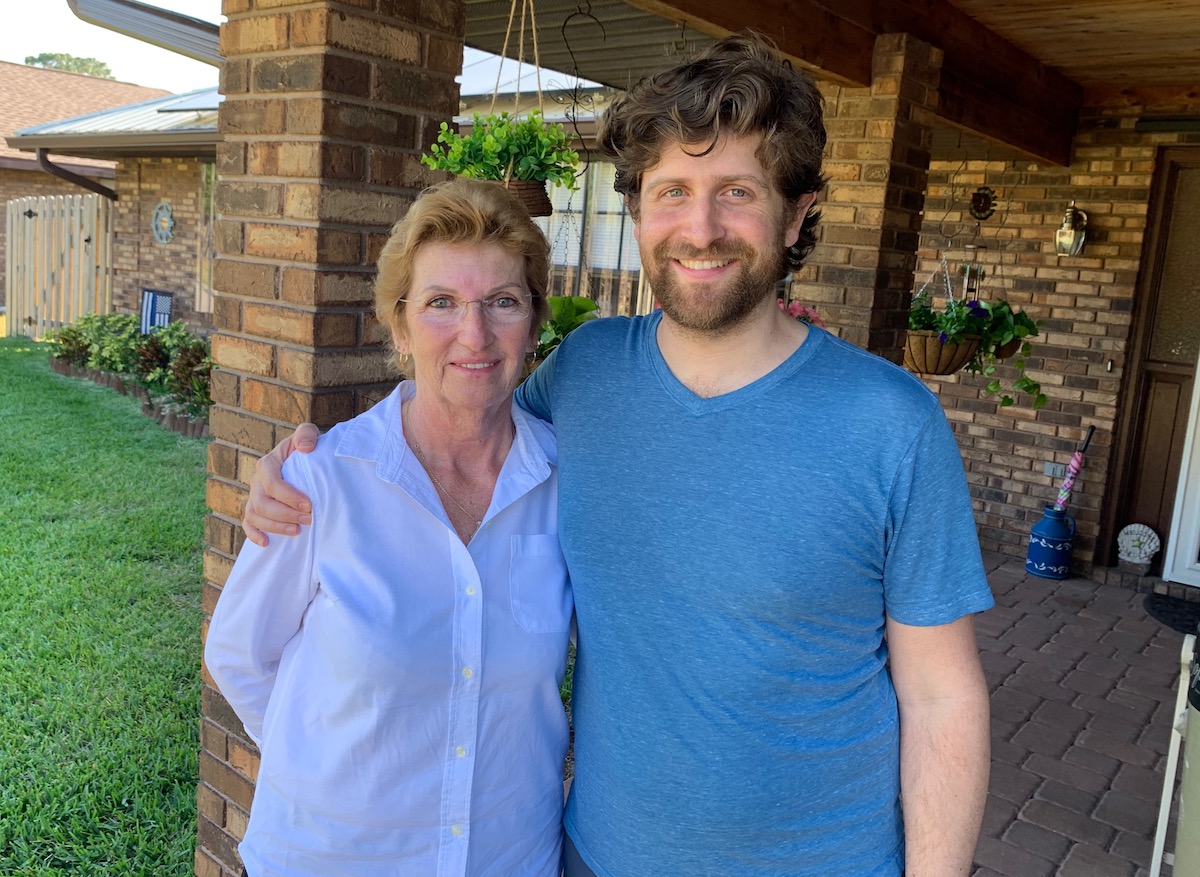 Sue Keane and Ted Walter at Sue’s home in Palm Bay, FL.
Sue Keane and Ted Walter at Sue’s home in Palm Bay, FL.
To help Sue prepare her witness statement for the inquest application, I started studying her handwritten police report and her chapter in Women at Ground Zero more carefully. I was surprised to discover that she had witnessed several explosions, not just one or two.
Over a few long phone calls, we read both documents together and discussed every detail she could remember. She came to the conclusion that she had witnessed five distinct explosion events — two while she was inside the lobby of the North Tower and three while on the northern side of WTC 5 after evacuating the North Tower.
She then went about composing her witness statement by quoting passages from each document and explaining her current understanding of the chronology of events described in those passages. In her statement, she also recounted her startling 2003 interview with the 9/11 Commission and the National Institute of Standards and Technology (NIST), which had never been publicly documented but for a few nondescript footnotes in the 9/11 Commission Report that read “PAPD interview 4, Port Authority Bus Terminal Command (Nov. 23, 2003).” (Sue was assigned to the Manhattan Criminal Court at 100 Centre Street during the period when 9/11 happened, but her official station was the Port Authority Bus Terminal.)
Although Sue is no longer with us, her witness statement will continue to be a part of the Campbell family’s application — which must remain confidential while it is being reviewed by the UK attorney general — and it will be submitted as evidence if there is a new inquest. But sadly, she will not be there to describe her experience to the coroner in more detail.
This is my attempt to tell the story of the events Sue witnessed and of the many lives she saved. It is primarily a synopsis of the facts she attested to in her witness statement, supplemented by details from my later interview with her in Florida.
Sue’s account of September 11, 2001
From around 9:00 AM, which was 14 minutes after the first airplane struck the North Tower, until the South Tower came down at 9:59 AM, Sue was positioned outside Stairwell C on the west side of the mezzanine level of the North Tower lobby. The red star inside WTC 1 (i.e., the North Tower) in the figure below denotes Sue’s location during this first hour.
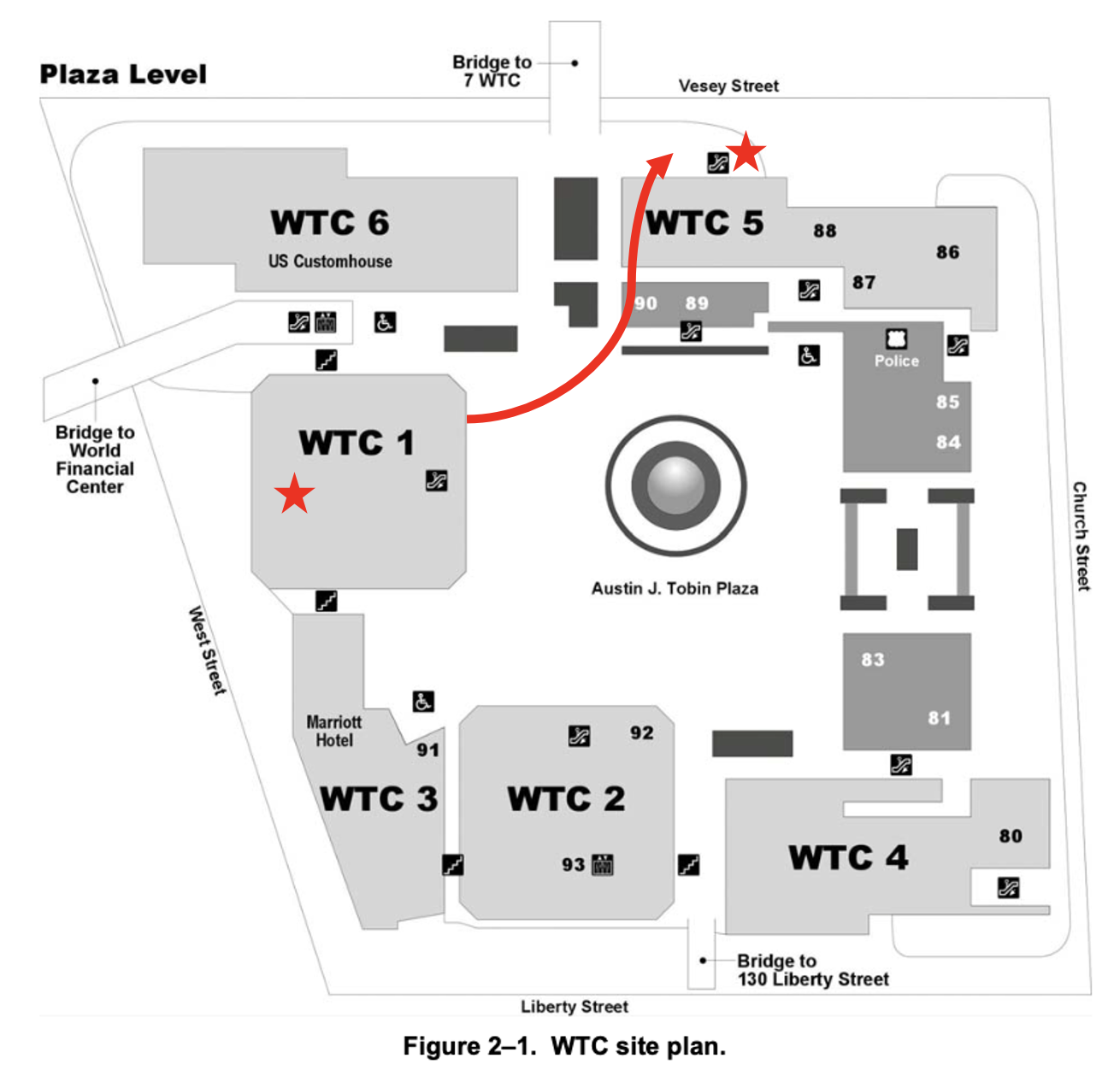 This figure from NCSTAR 1-7 of the NIST report provides a map view of the WTC complex. The star inside WTC 1 denotes Sue’s location at the time of the South Tower’s destruction at 9:59 AM. The red line approximates her escape route from the North Tower to WTC 5. The star at the top, next to WTC 5, denotes her location at the time of the North Tower’s destruction at 10:28 AM.
This figure from NCSTAR 1-7 of the NIST report provides a map view of the WTC complex. The star inside WTC 1 denotes Sue’s location at the time of the South Tower’s destruction at 9:59 AM. The red line approximates her escape route from the North Tower to WTC 5. The star at the top, next to WTC 5, denotes her location at the time of the North Tower’s destruction at 10:28 AM.
Outside Stairwell C, which ended at the mezzanine level, Sue and other law enforcement officers were directing evacuees, who had just walked down as many as 90 flights of stairs, over to the escalator on the east side of the mezzanine. (The escalator is denoted by the black escalator symbol inside WTC 1.) Once there, the evacuees descended the escalator to the main lobby level, also known as the “concourse level.” They then exited through the concourse, which was an underground shopping mall underneath the outdoor plaza in the middle of the complex. The concourse connected the Twin Towers and also led to a large underground subway station. Evacuees were directed to take this subterranean route so that they would not exit from the mezzanine to the outdoor plaza, where they could be struck by falling debris or bodies.
According to NIST, at least 19 percent (although probably closer to 30 percent) of the estimated 7,470 people who evacuated the North Tower traveled through Stairwell C. That is essentially the number of people Sue helped direct to the escalator on the other side of the mezzanine after they exited the stairwell.
The photos below provide a visual of where Sue was and the route taken by evacuees.
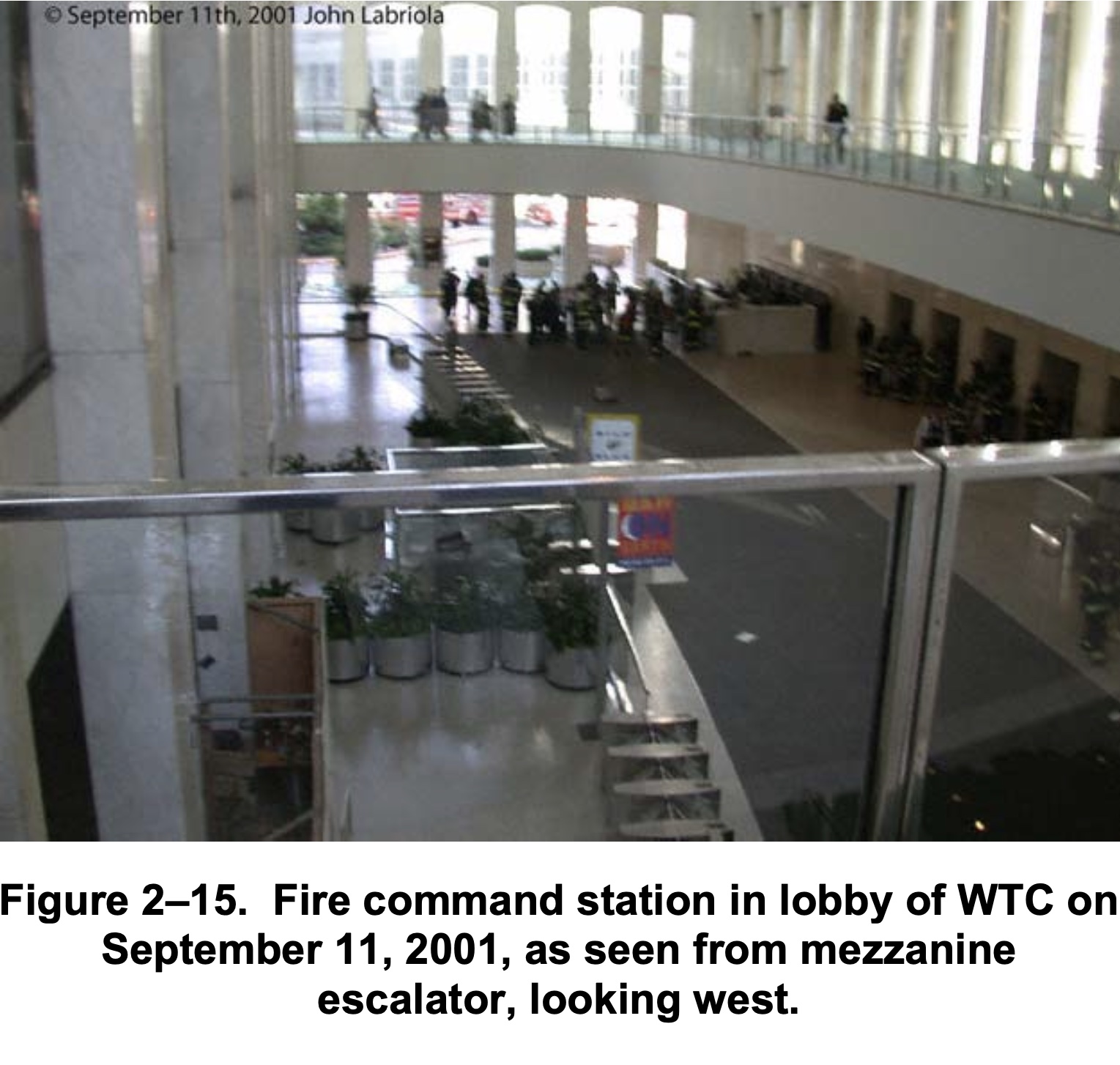 In this figure from NCSTAR 1-7 showing the North Tower lobby, the top floor with the railing is the mezzanine. The photo is taken from the east side of the mezzanine, looking westward to the west side of the mezzanine, where Sue was positioned. The lower floor, at ground level, is the concourse level. The west side of the concourse level — which was the only side that had windows — looked out to West Street. The east side of the concourse level led to the underground shopping mall.
In this figure from NCSTAR 1-7 showing the North Tower lobby, the top floor with the railing is the mezzanine. The photo is taken from the east side of the mezzanine, looking westward to the west side of the mezzanine, where Sue was positioned. The lower floor, at ground level, is the concourse level. The west side of the concourse level — which was the only side that had windows — looked out to West Street. The east side of the concourse level led to the underground shopping mall.
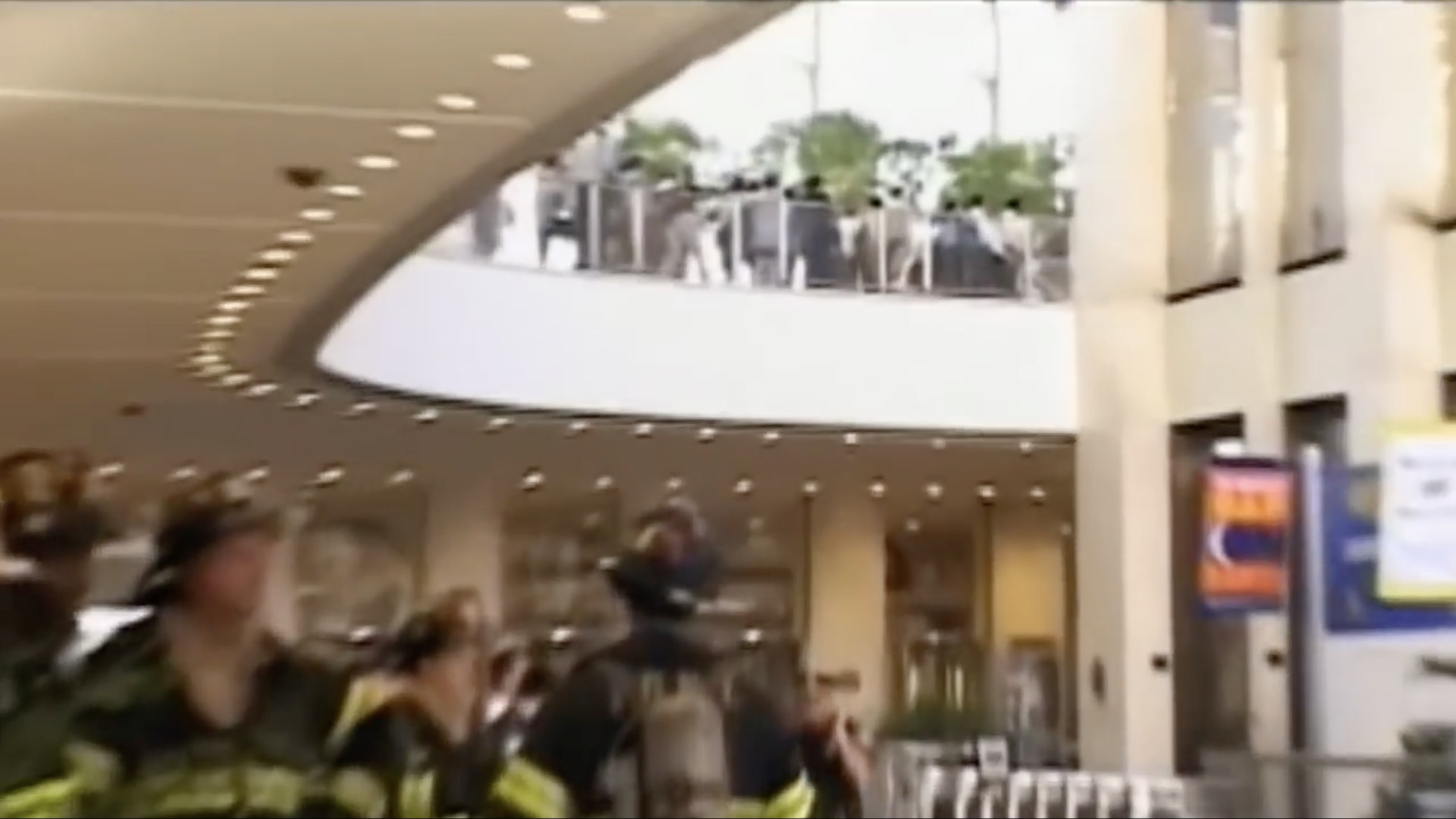 This screenshot from “9/11” by Jules and Gédéon Naudet provides an eastward view from the concourse level up to the east side of the mezzanine, where evacuees can be seen — in front of the plants — lining up to go down the escalator. This is the escalator Sue was directing people to after they exited Stairwell C. Below the mezzanine, on the concourse level, is the exit to the underground shopping mall.
This screenshot from “9/11” by Jules and Gédéon Naudet provides an eastward view from the concourse level up to the east side of the mezzanine, where evacuees can be seen — in front of the plants — lining up to go down the escalator. This is the escalator Sue was directing people to after they exited Stairwell C. Below the mezzanine, on the concourse level, is the exit to the underground shopping mall.
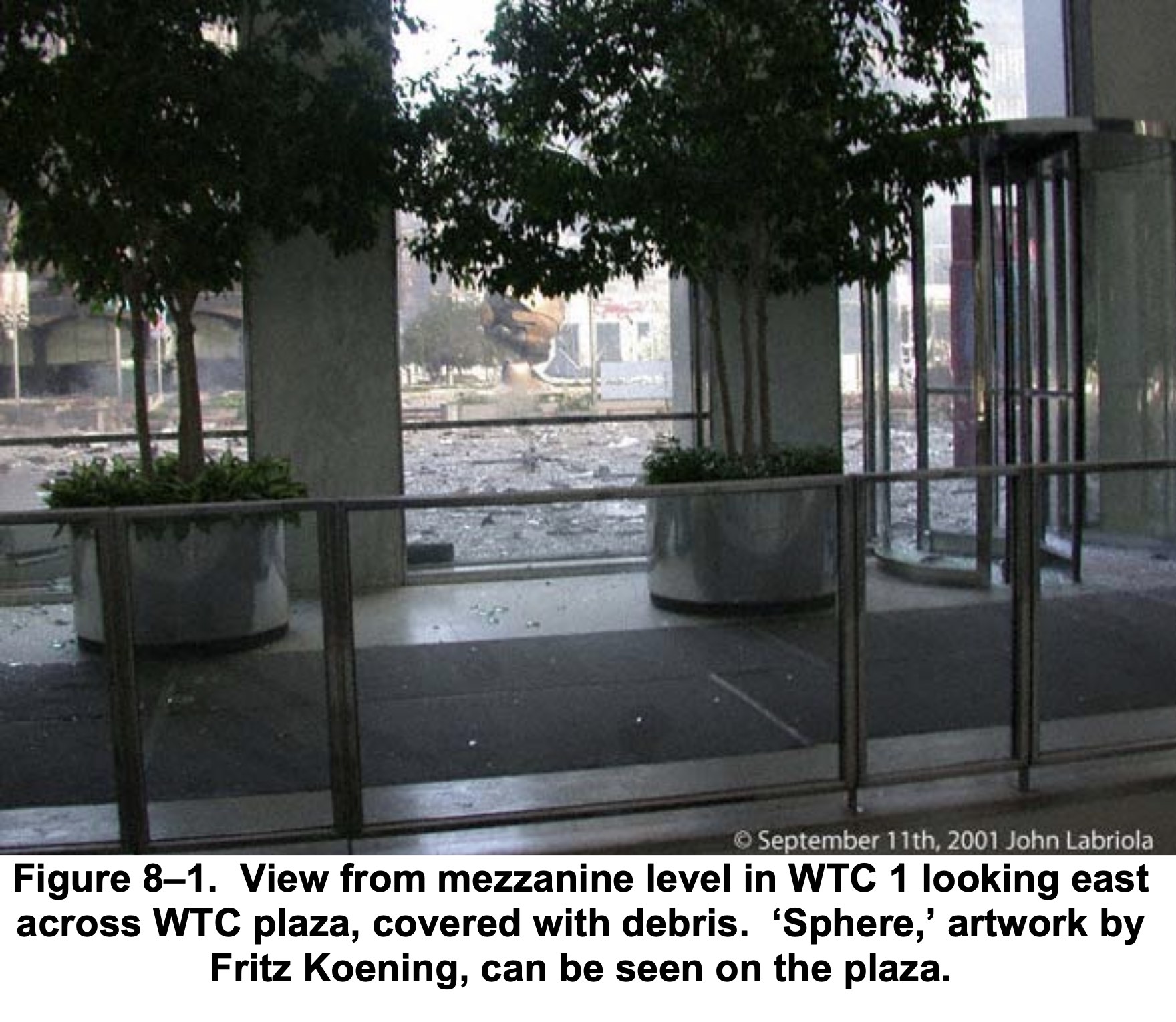 This figure from NCSTAR 1-7, looking from the east side of the North Tower lobby mezzanine, near the escalator, gives an eastward view of the debris-covered plaza.
This figure from NCSTAR 1-7, looking from the east side of the North Tower lobby mezzanine, near the escalator, gives an eastward view of the debris-covered plaza.
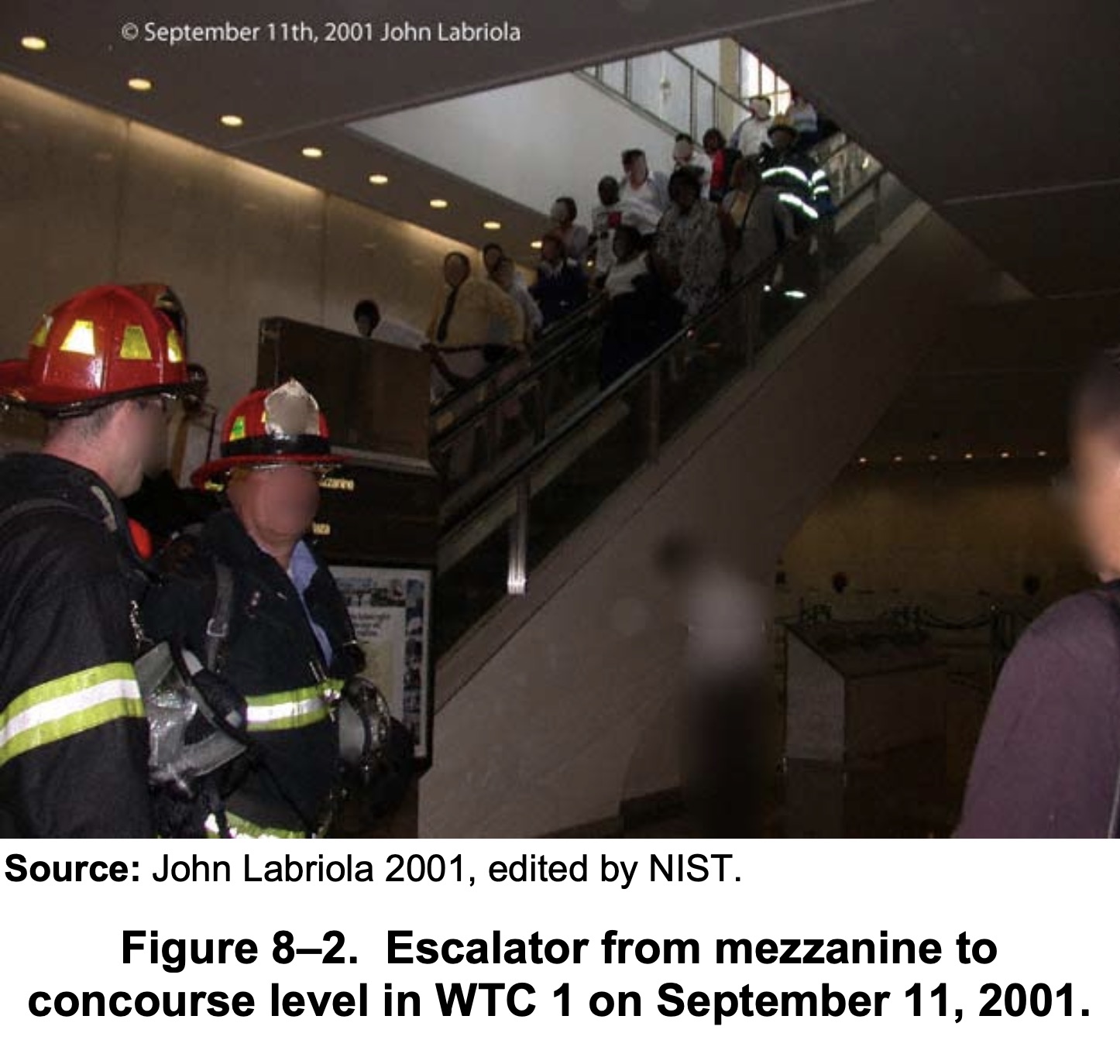 This figure from NCSTAR 1-7, which looks northwest inside the North Tower lobby, shows the escalator from the mezzanine, which is at the top, down to the concourse level, where the firemen are standing.
This figure from NCSTAR 1-7, which looks northwest inside the North Tower lobby, shows the escalator from the mezzanine, which is at the top, down to the concourse level, where the firemen are standing.
The first explosion event that Sue witnessed was associated with the demolition of the South Tower at 9:59 AM. Having served in the U.S. Army for 13 years before joining the PAPD, she was trained in how to respond to explosions, and this may have saved her life and the life of the man she jumped on top of. She described this harrowing moment in Women at Ground Zero this way:
“A couple minutes later, it sounded like bombs going off. That’s when the explosions happened. I could hear it coming, and I knew something was going to happen. I braced myself. It started to get dark, then all the sudden there was this massive explosion. We were on the mezzanine, which is all encased in glass. The windows blew in, everything went black, and we all got thrown.
“In the military, they blow things up around you so you’re not afraid of it. You don’t panic. If something blows up, we cover, we breathe into our shirts, we wait for it to pass over, then we look up before we get up. All that stuff stayed with me. I jumped on the old guy to protect him, and I remember thinking, ‘If he wasn’t already having a heart attack, I just killed him.’
“There was this incredible rush of air, and it literally sucked the breath out of my lungs. Everything went out of me with this massive wind. I instinctively pulled my shirt over my face like a mask. Stuff was just flying past. Then it stopped and got really quiet, and then everything came back at us. I could breathe at that point, but now I was sucking all that stuff in, too. It was almost like a back draft. It sounded like a tornado.” [Underlining added.]
Sue’s description of the first explosion event she witnessed includes four out of the six characteristics of explosions noted by Graeme in his 2016 presentation: sound, positive blast pressure phase, partial vacuum during positive blast pressure phase, and negative blast pressure phase. The notion that any of the phenomena Sue witnessed can be explained by a building collapse is, in my view, preposterous. But it is especially inconceivable that a building collapse could account for the wind being sucked out of Sue’s lungs (the partial vacuum) and for everything coming back at her (the negative blast pressure phase).
The sounds of bombs going off and the windows of North Tower lobby blowing in, as described by Sue, are dramatically captured in Jules and Gédéon Naudet’s 2002 documentary 9/11, which is embedded below (and cued up to that moment). One key difference, however, is that Jules Naudet and the FDNY officials he was filming were on the concourse level of the North Tower, which is mostly underground (except for the West Street side) and did not have a direct line of sight to the South Tower. Also, Naudet and the FDNY officials were able to run to a somewhat sheltered area at the base of an escalator on the north side of the concourse level. Sue, on the other hand, was one floor above, on the mezzanine, which was fully surrounded by windows and had a direct line of sight to the South Tower.
This is not to minimize the danger and the harm caused to the people on the North Tower’s concourse level. Indeed, FDNY Chaplain Mychal Judge, who was among the group of FDNY officials being filmed by Jules Naudet on the concourse level, was one of many people killed in the North Tower lobby by flying debris (undoubtedly propelled by a blast wind that could not have been generated by a neighboring building simply collapsing). Father Judge was found dead immediately after the South Tower’s destruction, possibly at the base of the escalator where the group had gone to seek cover, as documented at the 55:10 mark below.
“9/11” by Jules and Gédéon Naudet. The video is cued up to the start of the South Tower’s demolition. The death of Father Mychal Judge in the North Tower lobby is discussed at the 55:10 mark. (It appears this video must be watched on YouTube because it is age-restricted. If it does not start at the right place, the timecode for the start of the South Tower's demolition is 50:50.)
Then, at the 56:00 mark, the group of FDNY officials is seen going up the same escalator, heading away from the North Tower lobby, to what appears to be a sheltered area that leads to the covered bridge connecting the World Trade Center complex to the World Financial Center. Here, at the top of the escalator, just like in the North Tower lobby, the windows appear to be blown out and the air is saturated with dust — even though this area was shielded from the South Tower by the North Tower.
At the 56:44 mark, we see an official, apparently with the NYC Office of Emergency Management, say into his walkie talkie: “[Inaudible] World Trade Center. We took a hit on that last explosion.” Indeed, as Graeme and I have documented in other articles, it was the dominant interpretation among emergency personnel and news reporters on the ground that a major explosion had just taken place.
Sue, meanwhile, was still on the west side of the mezzanine by Stairwell C. As a result of the blast wind, the door to the stairwell had slammed shut and become blocked by a large object, and she could hear officers trying to get out. An NYPD captain urged her to leave, but she insisted on helping the officers in the stairwell. This, one of her many heroic acts that day, may have saved countless lives. Quoting Sue again in Women at Ground Zero:
“When the explosion happened, there were officers in the stairwell. The door slammed shut, and there was something blocking the front of it. The guy in the brown suit got up and he was okay, and the captain grabbed me and said, ‘C’mon, let’s get out of here!’ I turned around and heard the officers in the stairwell banging on the door. There was a buckle in the doorframe, and I could see their flashlights through the crack. I pulled myself away from the captain and said, ‘No, I’ve gotta get back over there.’ The captain left with the man in the brown suit, but all these people were trapped in the stairwell, and I wasn’t going to leave them behind.
“It was pitch black now, and I followed the wall back to where I could see the light behind the buckle in the doorframe. I slid my back down the wall and took my feet and pushed whatever was blocking the door out of the way. . . .
“There was no handle on the outside of the door, so I yelled through the door, ‘Go ahead! Open the door! Open the door!’ They pushed the door open, took one look at the blackness behind me, and pulled me into the stairwell. . . .
“People were still coming down, and we walked up the stairs to see if we could find anyone else. By the time we came back down and opened the door again, everything looked white. It looked like a massive dustbowl out there. It looked like a war zone, like what you see on TV happening in Israel and Ireland. People were still coming out, and we were all shaking off our shock.”
At that point, which was perhaps five to 10 minutes after the South Tower’s destruction, the second explosion event that Sue witnessed while inside the North Tower took place. Quoting Sue again in Women at Ground Zero:
“Then it got really quiet again. I don’t know if anybody else felt it, but when it got really quiet, I looked around and said, ‘This isn’t good. Something’s going to happen.’
“Then everything started turning black again, and I heard that noise again that sounded like a railroad train coming. I told everybody, ‘Get out of here!’ and that’s when the second explosion happened and I got thrown and separated from the other guys. I turned around, and all I saw was a beam falling. Or maybe it was a floor. I was on one side of it with a couple NYPD officers and some fire fighters, and the Port Authority guys were on the other side. At that point, you couldn’t tell what was what. There was paper flying and copy machines falling. And that’s when the body parts started to fall. [Underlining added.]
Sue did not speculate in her witness statement as to the cause of this second explosion. She merely described what she witnessed, where she witnessed it, and when she believed it took place. My best guess is that this was one or more explosions occurring inside the North Tower, which then caused a part of the structure above the six-story-tall lobby to come crashing to the ground.
The idea of explosions going off in between the destruction of the towers at 9:59 AM and 10:28 AM may seem surprising, but there is indeed corroborating evidence of explosions happening during this period (not that they are necessarily the same explosions Sue witnessed).
For example, after the destruction of the South Tower, FDNY Firefighter Louie Cacchioli witnessed an explosion from the 24th floor of the North Tower that cut the power in the elevator he was in. In the first video below, he describes going up to the 24th floor. (At the end of the video, he also says the North Tower “blew” — again reflecting the dominant interpretation among emergency personnel and reporters on the ground.) In the second video below, during a speech he gave in 2014, Cacchioli describes hearing a rumbling, an explosion, and three maydays. This appears to have been the South Tower’s demolition, as it is consistent with the accounts of other FDNY personnel who were on nearby floors in the North Tower when the South Tower came down. He then describes hearing a subsequent explosion that knocked out the power in the elevator. This is conceivably the same explosion Sue witnessed from the lobby.
FDNY Firefighter Louie Cacchioli on ABC 7 News on September 11, 2001.
Then-retired FDNY Firefighter Louie Cacchioli giving a speech about his 9/11 experience in 2014.
Another example of explosions going off between the destruction of the two towers is from the FDNY oral history of Captain Karin DeShore. Looking up at the North Tower from her position west of it, she witnessed a series of explosions traveling around the face of the building midway up the tower — well below where the fires were — shortly before that tower was demolished:
“I went outside to see what I could do, when I saw the second building of the World Trade Center, still unbeknown to me the first one had collapsed.
“Somewhere around the middle of the World Trade Center, there was this orange and red flash coming out. Initially it was just one flash. Then this flash just kept popping all the way around the building and that building had started to explode. The popping sound, and with each popping sound it was initially an orange and then a red flash came out of the building and then it would just go all around the building on both sides as far as I could see. These popping sounds and the explosions were getting bigger, going both up and down and then all around the building.”
“So here these explosions are getting bigger and louder and bigger and louder and I told everybody if this building totally explodes, still unaware that the other building had collapsed, I’m going in the water.”
Yet another example is the unmistakable explosion captured on video at the intersection of West Broadway and Murray Street, two blocks north of World Trade Center Building 7 (the location of this event is analyzed on pages 71 and 72 of the NIST WTC 7 request for correction). This footage appeared in the documentary 9/11 Stories from the City, which places the explosion chronologically between 10:15 AM and 10:28 AM.
Video footage taken at the intersection of West Broadway and Murray Street, apparently between 10:15 AM and 10:28 AM, captures the sound of an explosion emanating from the direction of the World Trade Center.
Shortly after Sue witnessed her second explosion event, she escaped from the North Tower with several law enforcement officers and civilians. Amidst the chaos and their urgent need to get out of the building, the group ended up traversing the very route across the plaza which was so dangerous that they had been preventing evacuees from taking it earlier. Quoting Sue again in Women at Ground Zero:
“There were still some people there, and there was a doorway to the outside toward Building Five. We had to look up before we went out because body parts and things were falling from above. . . .
“This guy — I had no idea who he was — said, ‘You gotta look up, you gotta let me know when it’s clear. I’m only going to let two through at a time.’
“Everything was dusty. I don’t know what time it was, but you would have thought it was the middle of the night. I crossed over to Building 5, and I didn’t know what I was stepping on. I didn’t know if it was a beam, a copier, or a body part. I was hoping that whatever I stepped on didn’t squish. I didn’t look down; I only looked up to get those people across safely.
“We did that for a good 10 to 15 minutes, then that guy came across and the door slammed shut, and we didn’t see anybody else come out. There were two firefighters and a civilian guy there with me, and we were standing outside Five World Trade.”
The four of them then entered WTC 5 and made their way to the other side of the building, where there was an outdoor escalator that went down to Vesey Street, which bordered the north side of the World Trade Center complex. (The red star at the top of the WTC site plan above denotes Sue’s location at this time.) Today, this escalator and the staircase that was connected to it are known as Survivors’ Staircase, because they served as an escape route for several hundred people from WTC 5. The staircase portion now sits in the 9/11 Museum.
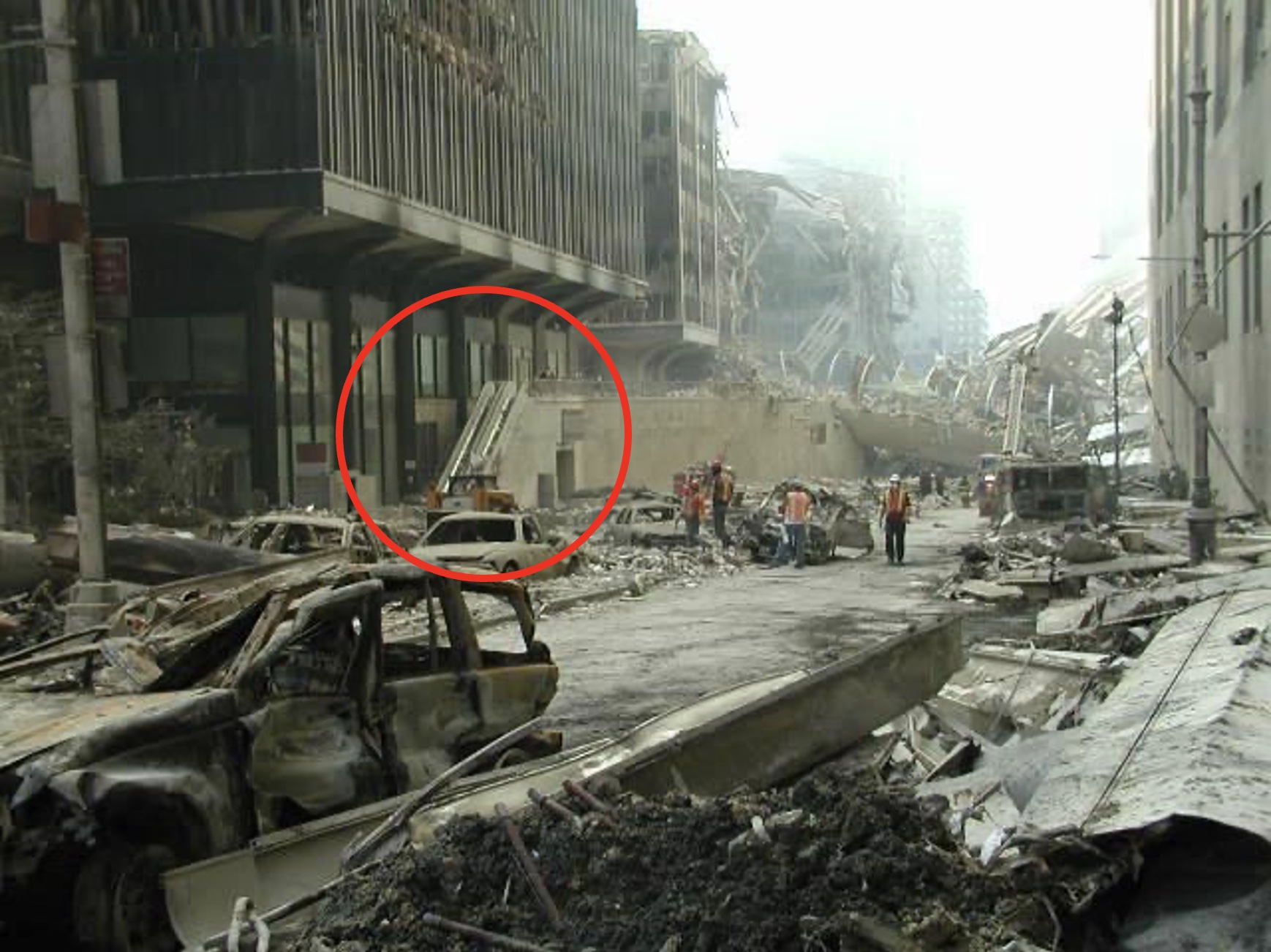 This photo, which looks west down Vesey Street, shows the northern side of WTC 5 on the left. Survivors’ Staircase, which led from WTC 5 to Vesey Street, is circled in red.
This photo, which looks west down Vesey Street, shows the northern side of WTC 5 on the left. Survivors’ Staircase, which led from WTC 5 to Vesey Street, is circled in red.
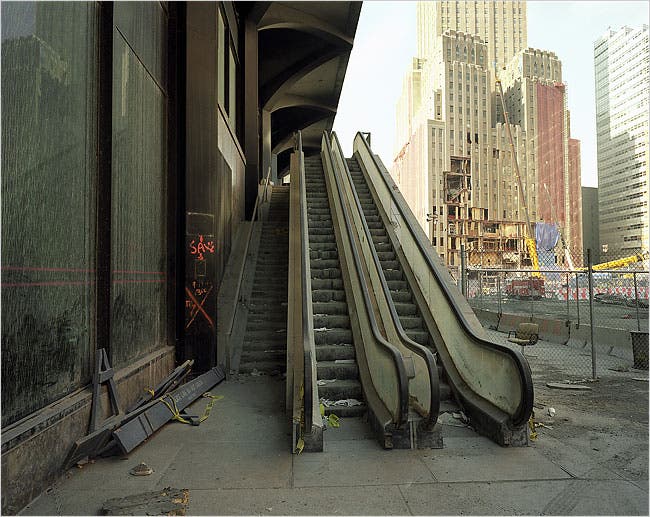 Looking up Survivors’ Staircase from Vesey Street.
Looking up Survivors’ Staircase from Vesey Street.
It is in the vicinity of Survivors’ Staircase that Sue witnessed three more explosion events, though the first two may have been different phases of the same event. Sue describes all three explosion events in this passage from Women at Ground Zero:
“We went into Building Five, and another firefighter was hollering, ‘We can get out this way!’ Building Five had an escalator that went down to Vesey Street. We were standing at the top of this escalator, and I saw some guys from the Emergency Services Unit down at the bottom. They were helping a very heavy woman we had gotten out of the stairwell about an hour before. I thought, Jesus Christ. I saw her two explosions ago. . . .
“All of a sudden, everything went quiet again. I said to the guy behind me, ‘Brace yourself,’ and again, another explosion. That sent me and the two firefighters down the stairs, on top of the ESU guys. Again, everybody shook off and got up and tried to regroup. We were trying to get this woman up, and she was really heavy and out of breath; I don’t even know if she made it.”
“I heard the rumbling again, like a locomotive coming. We all jumped on top of each other and huddled up against Building Five. I may have been in military mode, but there was a part of me that was scared to death. I didn’t think I was getting out of there alive.
“Then the same thing happened again, where the wind sucked the breath out of me. I held on to everybody and put my face in my shirt. I braced myself, because I knew that whatever went that way was coming back this way. I think they knew it, too, because none of the others moved.
“Whatever came back, came back in my eyes. We got up and were trying to get the woman on a backboard, and I said, ‘Guys, I can’t hold on, because I can’t see.’ I felt useless, because I was tired and I was getting sore. I can’t tell you how many times I got banged around. Each one of those explosions picked me up and threw me, but I never got caught on anything, which was amazing. I had to have had a guardian angel there with me.
“There was another explosion, and I got thrown with two firefighters out onto the street. I looked over where the guy had been helping that lady, and there was no one there. I didn’t hear them, and I couldn’t see the light on their helmets. Nothing. To this day, I still don’t know what happened to them.” [Underlining added.]
The first explosion event, which sent Sue and others flying down the escalator outside WTC 5, either occurred just before the North Tower’s demolition or was the first phase of the blast wind generated by that demolition. Given the timing, and given that she was northeast of the North Tower and was thrown eastward, there is little doubt that the force emanated from the North Tower.
The second explosion event, which she experienced at the base of the escalator, appears to have been when the North Tower was coming down. When I interviewed her in person, Sue told me that huddling up against the wall underneath the overhanging portion of WTC 5 (which can be seen in the photo above) probably saved her life, as debris from the North Tower came raining down on the street in front of them.
The third explosion event threw her and two firefighters from the sidewalk onto Vesey Street. It is less clear what the source of the third explosion was, though a plausible explanation is that it was still-reacting nano-thermite (which has explosive properties) attached to a piece of debris that had fallen near them.
It is also not clear how soon after the third and fourth explosion events this fifth explosion event occurred. But there is ample corroborating evidence of additional explosions occurring after the North Tower’s destruction. For instance, there are several TV news reports, shown in the video embedded below and listed on pages 74 to 77 of the NIST WTC 7 request for correction. Other examples include two radio dispatches by FDNY personnel at 10:48 AM and 10:50 AM, respectively, which are also embedded below.
This report from CBS’s Carol Marin of an explosion occurring at 10:44 AM, which appears to be the same explosion reported by NY1’s Kristen Shaughnessy at 10:45 AM, is especially worthy of highlighting (both reports are in the video embedded below):
“After the second tower went down, I was trying to make my way to a CBS crew or to try to help CBS crews if I could. And then, I don’t know what it was, John. But another explosion, a rolling blast of fire, a rolling column of fire towards us. . . . [A] firefighter threw me into the wall of a building, covered me with his body as the flames approached us. And another police officer in New York named Brendan Duke, wherever he is, got me through smoke that neither one of us could see more than about a foot ahead of us. . . . [W]e heard a rumble like I’ve never heard before, and a firefighter ran towards me. We ran as fast as we could. I lost my shoes. I fell down. He picked me up and slammed me into a wall and covered me with him until we could make it more to safety. . . . John, I looked at my watch. It was about 10:44, is what my watch said. So it was after the second tower, I think the second tower explosion.”
TV news reporters report continuing explosions between 10:38 AM and 12:00 PM.
A radio dispatch made by an FDNY member with the codename “8 Boy” on the EMS Citywide channel at 10:48 AM: “I’m on West Broadway. Everything’s exploding around us.”
A radio dispatch made by an FDNY member with the codename “5 David” on the EMS Citywide channel at 10:50 AM: “I wish I could give you an exact location. I can’t read anything for now. Shit’s still exploding over here.”
Whatever the cause of the fifth explosion event, the phenomena Sue witnessed near Survivors’ Staircase, just like the phenomena she witnessed in the North Tower lobby, clearly included four of the six characteristics of explosions outlined in Graeme’s 2016 presentation. It would be absurd to think that a mere gravity-driven building collapse — particularly one that she was largely shielded from while huddled against WTC 5 — could account for these phenomena.
From there, Sue journeyed northward up Church Street, coated head-to-toe in dust and debris, searching for other Port Authority officers. It was during this time that she first realized she was covered in burns and had shrapnel embedded in her body. Quoting Sue again in Women at Ground Zero:
“A firefighter grabbed me and said, ‘Are you okay?’ I said ‘Yeah, but I gotta find the Port Authority.’ They had a hose going, and they threw me under this hose, which in a way felt great, because I didn’t realize until then that my skin was actually burning.
“I had burn marks, not like you’d have from a fire, but my face was all red, my chest was red, and for three or four days there was stuff coming out my body like you wouldn’t believe. It was like shrapnel. It’s still coming out. I’ll look over and have this little pinpoint under my skin and it will be bleeding. My doctor says, ‘Welcome that. Your body has its own natural immunity, and it’s going to reject anything that doesn’t belong there,’ which it did for days. I was coughing up black stuff, and there was black stuff coming out of my ears and my nose. There was so much stuff in my eyes.”
Sue told me during our interview in her home that the shrapnel continued to be expelled from her body more than a decade after the event. Like the other phenomena indicative of explosions, it is unfathomable to think that these injuries were caused simply by being in the vicinity of two collapsing buildings.
When Sue left the site of the demolished World Trade Center, she believed, quite accurately, that she had narrowly survived a major bombing incident. But it would be a struggle for her to keep hold of that truth for the next 20 years.
Sue’s interview with the 9/11 Commission and NIST
For the first two years after 9/11, Sue’s mental and physical survival demanded all of her attention. She was also mourning the loss of 37 PAPD colleagues, most of whom she called friends, and countless other first responders whose funerals she attended. But, as she shared in our conversations, in the back of her mind lingered the question of what actually happened that day.
On the one hand, Sue was certain that she had witnessed explosions. On the other hand, the official story of the buildings simply collapsing was everywhere she looked.
The coexistence of these two conflicting narratives is on display in her chapter from Women at Ground Zero. She unhesitatingly speaks about witnessing explosions. Yet she also mentions being told that the explosion sounds she heard were caused by the floors hitting each other. It is unclear whether she accepted that explanation at the time:
“Someone told me later that the explosion sounds I’d heard were actually the cement floors hitting each other when Tower Two was coming down. I never in a million years would have thought the building would fall. I never would have thought that Tower Two had been compressed into seven floors.”
Sue told me once over the phone and during our sit-down interview that there was occasional chatter within the department about the buildings having been brought down with explosives. But it was always in private one-on-one conversations, because her fellow officers did not want to talk about their experiences of that day out in the open. Sue mentioned one conversation where a colleague said to her, “Yeah, I kind of heard the same thing.” They expressed mutual incredulity that the sound could have been caused by pancaking floors.
Two years after 9/11, on November 23, 2003, Sue’s tenuous grasp of the truth about what she witnessed that day was dealt a major blow by her interview with the 9/11 Commission and NIST. I was in awe, but not really surprised, to learn that investigators from both of these entities sat there and categorically denied to Sue throughout her interview that she had witnessed explosions.
She recounted, both in her witness statement and later when we met, that she was interviewed for at least two hours by around 10 men who identified themselves as high-ranking government officials (she vaguely remembered that some of them may have been congressmen), engineers, and scientists. Sue recalled that they had copies of her handwritten police report in front of them and that they seemed quite familiar with her story before she walked in.
According to Sue, they were extremely courteous and sensitive to the mental and physical trauma she had suffered. They offered to answer whatever questions she had, and they insisted that she take breaks or stop altogether if it became too difficult for her to go on.
After some time, discussion of the explosions she witnessed finally commenced when she asked them how it was that she got thrown so many times yet she did not get hurt. I am no expert in the techniques of interrogation used by investigators to elicit responses that fit the story they are trying to construct, but it seems to me that encouraging Sue to ask questions was a way for them to do exactly that.
It was through their answer to this question that the investigators began to explain that the sounds she heard were caused by the concrete floors slamming on each other. They claimed that the “tornado winds” that picked her up and threw her 10 to 15 feet through the air were generated by the collapsing floors and debris. They even used a diagram of the towers to illustrate how the falling structure created a wind that entered the mezzanine.
Not convinced by their explanation, she pushed back several times, voicing her impression that there were explosions and emphasizing the “back draft” effect she felt. They chalked up this phenomenon to “inertia,” a word that Sue recalled them using many times throughout the exchange. She also remembered one investigator insisting that some of the explosion sounds were fax machines exploding, which she found especially unbelievable. When she mentioned that she had military training in how to respond to explosions and had seen things blow up in the past, a couple of the investigators noticeably moved in their chairs, as if caught off guard by her level of knowledge and by her direct comparison of what she witnessed on 9/11 to the explosions she witnessed while in the military.
Despite resisting their explanations at first, as Sue attested in her statement for the inquest application, she was ultimately persuaded to accept that the phenomena she witnessed were simply the effects of the buildings collapsing. But gradually, over time, she gravitated back to her original interpretation of what she had seen, heard, and felt.
In her witness statement almost 20 years after 9/11, she unequivocally declared that she now believed, as she did on that day, that the phenomena she witnessed were caused by explosions. Yet, in my interview with her a few months later, I could still see a tendency toward self-doubt. Such hesitation could be expected from someone who had been told for 20 years — and to her face by government officials — to discount her perception of what she had experienced.
Remembering Sue Keane
I knew Sue personally for less than a year, but I was looking forward to remaining friends and working closely with her for many years to come. I anticipated that, after she testified at Geoff Campbell’s new inquest, we would find other platforms for her to tell her 9/11 story.
My heart now aches over the premature passing of this remarkable woman. I do not know the specifics of her death, but I know she had a heart attack at the age of 47, and the mutual friend who informed me of her passing also told me of her ongoing heart condition resulting from her brief but intense exposure to the toxic World Trade Center dust. It seems very unlikely that Sue would have suffered this heart attack had she not been at the World Trade Center on the morning of 9/11.
Aside from being saddened by her loss and heartbroken for her family, I feel a sense of rage at the thought of what 9/11 did to her. Her mental and physical health were devastated for the last 20 years of her life. She lost dozens of friends in a single day. She went two whole decades being told that what she witnessed during the most traumatic moments of her life didn’t really happen. Worse, her story and many similar stories have been ignored, and will continue to be ignored, because they do not serve the official 9/11 narrative. (This article will be sent to thousands of journalists, and I won’t be holding my breath for one of them to tell Sue’s story truthfully.)
But while I am full of rage, I am more uplifted by the fact that Sue was not. She considered herself the “luckiest woman in the world” — lucky to still be alive and lucky to see her grandchildren.
It seemed that out of the ashes of 9/11, she somehow managed to build an active life centered on helping others. She remained friends with many of her Port Authority Police Department colleagues after retiring. She also stayed in touch with several of the other courageous first responders featured in Women at Ground Zero, whom she first met when the book was published in 2002.
I can see why our mutual friend called Sue a compassionate, selfless woman who will always be held close in the hearts of those who knew her — for she held them equally close. Witness, if you will, her 37 fallen PAPD brothers, whose portraits she framed and hung next to her front door so she could see them every day “as a reminder to fight forward.”
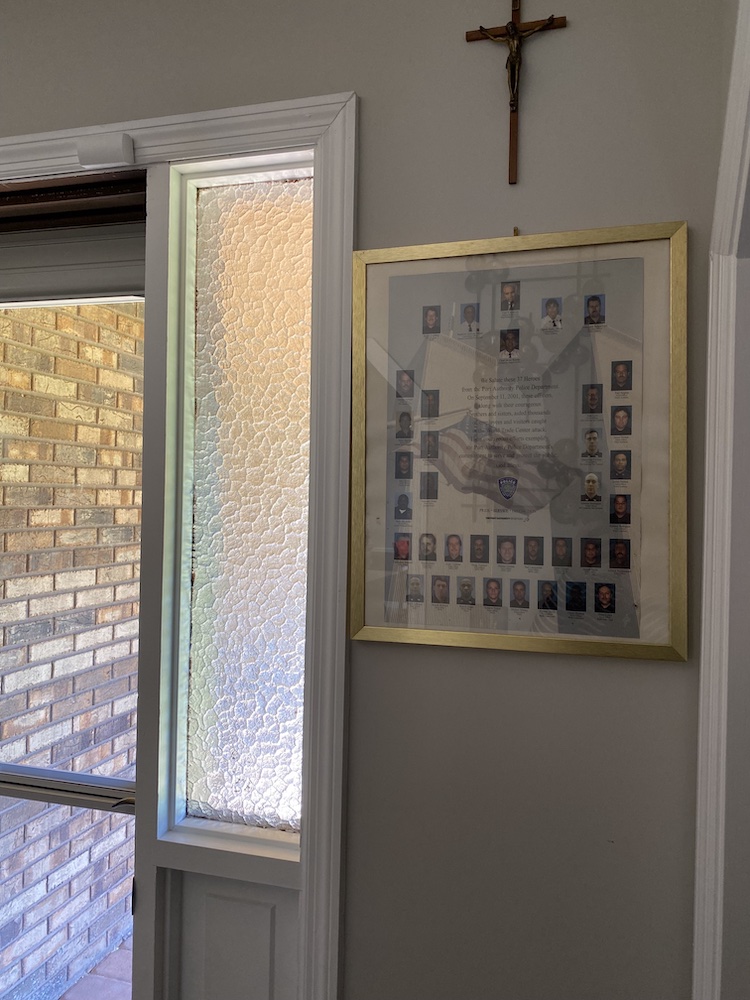
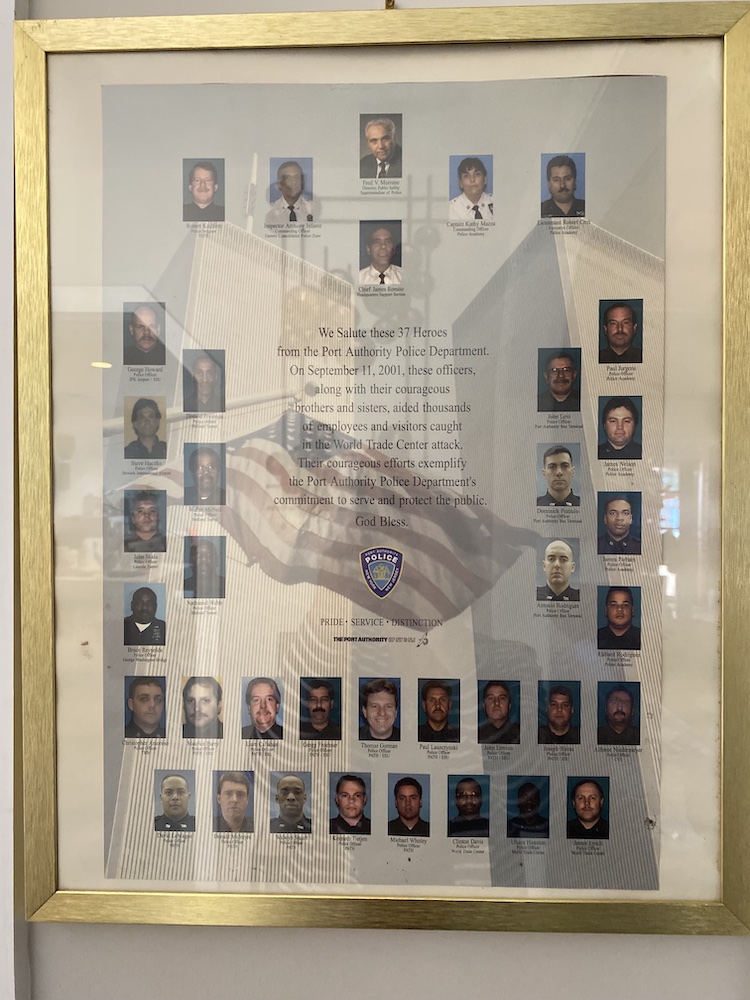 Portraits of the 37 fallen members of the Port Authority Police Department, which Sue Keane framed and hung next to her front door.
Portraits of the 37 fallen members of the Port Authority Police Department, which Sue Keane framed and hung next to her front door.
For my part, I will always remember Sue for her willingness to tell the truth. I hope her story of courage and candor will, in time, become more widely known and inspire other 9/11 survivors to come forward with their own.
Ted Walter is the director of strategy and development for Architects & Engineers for 9/11 Truth. His colleague Susan Clay contributed invaluable editing assistance to this article.


